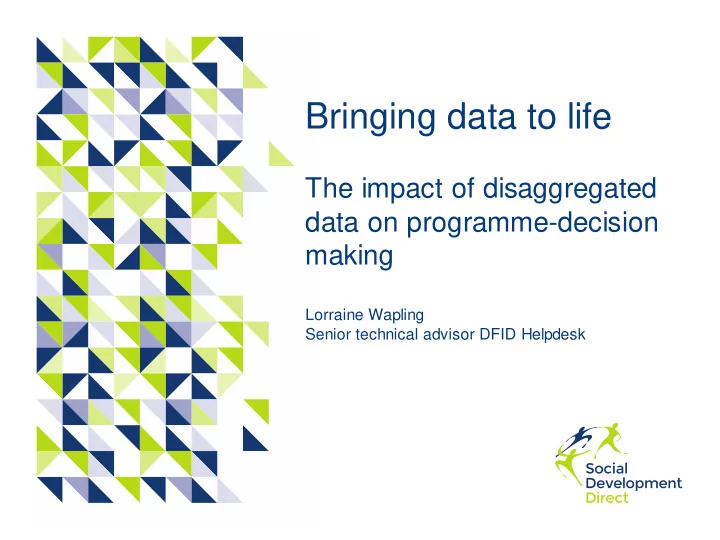

Bringing data to life The impact of disaggregated data on programme-decision making Lorraine Wapling Senior technical advisor DFID Helpdesk
Key challenges Collecting and collating data related to disability is a sticky problem ⇢ Invisibility of people with disabilities in the data; ⇢ Disability from a rights perspective is still poorly understood in mainstream development; ⇢ Homogenising of disabled people’s experiences. • General lack of documented experiences in relation to disability inclusion ( knowledge gap ) • Underestimation of the impact disability has on development outcomes
Changing landscape Building on the ‘ leave Goals with targets on no one behind disability agenda ’ the sustainable development goals (SDGs) explicitly reference persons with disabilities in targets and indicators Disaggregation of data by disability is encouraged across all SDGs (follow up and review)
The power of disaggregation Percentage of people in South Africa within each domain of functioning that are in receipt of a social grant, by level of severity Source: South Africa General Household Survey, 2015
Impact of disaggregation on programming: Girls Education Challenge Programme
Overview • The GEC was launched in 2012 and has invested £300 million in supporting 1.4 million marginalised girls get into 27 schools and accelerate their projects learning. • The GEC-Transition (GEC-T) GECT £355m 15 Funding Window was countries total funding commissioned by DFID in July 2016 to secure continuity for girls benefiting from GEC1 1,393,974 interventions; it runs from 2017 to beneficiaries* 2025. • 27 projects were approved and contracted for GEC-T . * Beneficiaries refer to direct girl learning beneficiaries. Note – Please refer to the Portfolio Analysis Report that contextualises these figures.
Disability in the GEC • From the start GEC-T defined disability using the rights- based approach in all project documentation. • All GEC-T projects were required to collect disability prevalence data from school and household surveys using Washington Group Short Set questions at baseline, midline and endline. • Data on disability was further disaggregated by domain of functioning and levels of difficulty. • GEC provided technical assistance to evaluation and programme teams via one-to-one sessions and through general webinars and written guidance.
Baseline findings • The disability disaggregated data collected by GEC-T projects reports an overall prevalence rate of 8.9% (standard cut off). • Most commonly, projects reported a 3% prevalence rate, with projects that had specific intentions to include disabled girls reporting above modal prevalence rates. • Many of the GEC-T projects did not actively plan or expect the inclusion of girls with disabilities.
Impact of disability data • The prevalence rate data prompted high levels of engagement with projects during review and adaptation meetings to talk through implications. • Where girls with disabilities were identified in cohorts, projects were supported through technical assistance, to ensure the activities were made as accessible and inclusive as possible . • This prompted a lot of discussions to ensure activities focused on barriers, avoiding an over- reliance on medical based interventions (such as provision of assistive technology or referral to specialist services).
Common programme strategies • T ackling negative attitudes (amongst staff, students and communities) during advocacy activities. • Focusing on building up disability inclusive classroom strategies with teachers when undertaking teacher training activities. • Establishing links with the disability movement and those providing more disability specific services (for example, disability NGOs). • Establishing connections with Ministries of Education Special Needs departments to link in with government services to help signpost disabled girls and their families and to increase demand for local run services. • Increasing disability rights awareness amongst project staff so they feel better equipped to focus on barriers.
Learning process • Quantitative research now underway: Understanding disability and learning outcome data within the GEC-T project portfolio. • Continual reflections and opportunities for sharing lessons – webinars, practice notes. • Ongoing programme support and technical advice. • Understanding challenges of intersectionality.
Thank you
Recommend
More recommend